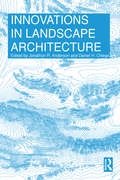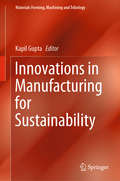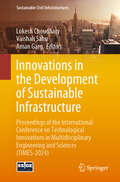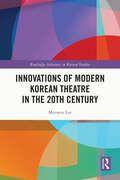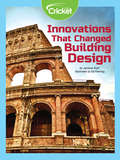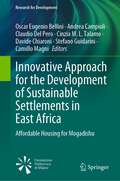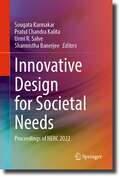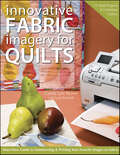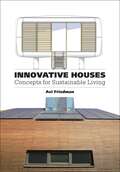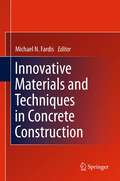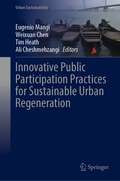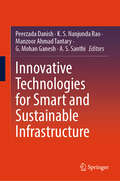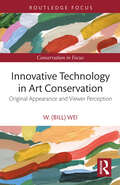- Table View
- List View
Innovations in Landscape Architecture
by Jonathon R. Anderson Daniel H. OrtegaThis inspiring and thought-provoking book explores how recent innovations in landscape architecture have uniquely positioned the practice to address complex issues and technologies that affect our built environment. The changing and expanding nature of "landscape" make it more important than ever for landscape architects to seek innovation as a critical component in the forward development of a contemporary profession that merges expansive ideas and applications. The editors bring together leading contributors who are experts in new and pioneering approaches and technologies within the fields of academic and professional landscape architecture. The chapters explore digital technology, design processes and theoretical queries that shape the contemporary practice of landscape architecture. Topics covered include: Digital design Fabrication and prototyping Emerging technology Visualization of data System theory Concluding the book are case studies looking at the work of two landscape firms (PEG and MYKD) and two academic departments (Illinois Institute of Technology and the Rhode Island School of Design), which together show the novel and exciting directions that landscape is already going in.
Innovations in Manufacturing for Sustainability (Materials Forming, Machining and Tribology)
by Kapil GuptaThis book provides details on the innovations made to achieve sustainability in manufacturing. It highlights the trends of current progress in research and development being done to achieve overall sustainability in manufacturing technology. Green-EDM, Hybrid machining, MQL assisted machining, sustainable casting, welding, finishing and casting, energy- and resource-efficient manufacturing are some of the important topics discussed in this book.
Innovations in Mass Timber: Sequestering Carbon with Style in Commercial Buildings
by Boyce ThompsonTrending topic on which there are few books, none written from a purely design point of view. Wooden Buildings Reach for the Skyhttps://www.nytimes.com/2021/07/30/todaysinyt/wooden-buildings-reach-for-the-sky-in-vaxjo-sweden.html?referringSource=articleShareFive Stories Tall and Made of Woodhttps://www.nytimes.com/2020/01/17/realestate/five-stories-tall-and-made-of-wood.html?referringSource=articleShareAs Concerns Over Climate Change Rise, More Developers Turn to Woodhttps://www.nytimes.com/2020/09/22/business/mass-timber-wood-buildings.html?referringSource=artichttps://www.nytimes.com/2019/11/20/style/engineered-wood-tower-construction.html?.?mc=aud_dev&ad-keywords=auddevgate&gclid=Cj0KCQjwg7KJBhDyARIsAHrAXaHHY8errrxRyekMa3u1yfaO3-hlB6P4tpWt23X1l9NnbkdQxH2J8z8aAtAcEALw_wcB&gclsrc=aw.ds
Innovations in Sustainable Energy and Technology: Proceedings of ISET 2020 (Advances in Sustainability Science and Technology)
by P. Muthukumar Dilip Kumar Sarkar Debasis De Chanchal Kumar DeThis book presents best selected research papers presented at Innovation in Sustainable Energy and Technology India (ISET 2020), organized by Energy Institute Bangalore (A unit of RGIPT, an Institute of National Importance), India, during 3–4 December 2020. The book covers various topics of sustainable energy and technologies which includes renewable energy (solar photovoltaic, solar thermal and CSP, biomass, wind energy, micro hydro power, hydrogen energy, geothermal energy, energy materials, energy storage, hybrid energy), smart energy systems (electrical vehicle, cybersecurity, charging infrastructures, IOT & AI, waste management, PHEV (CNG/EV) and mobility (smart grids, IOT & AI, energy-efficient buildings, mart agriculture).
Innovations in Topology Optimization: With Applications in Materials, Product Design, and Manufacturing (SpringerBriefs in Applied Sciences and Technology)
by Nikolaos Kladovasilakis Konstantinos Tsongas Dimitrios TzetzisThis book is a practical guide to the topology optimization process. It explains the fundamental theoretical underpinnings of topology optimization techniques andcovers hands-on implementation. The book also offers several real-world examples that illustrate the transformative power of topology optimization in enhancing product design. Through these case studies, the book demonstrates how the application of topology optimization can tangibly and measurably elevate the quality, efficiency, and functionality of a diverse range of products,further reinforcing its importance and effectiveness.
Innovations in Transportable Healthcare Architecture
by Stephen VerderberInnovations in Transportable Healthcare Architecture is the first book to examine the ways that healthcare architecture can provide better assistance in disaster-stricken communities. Aimed at architects and other professionals working across the disaster relief sector, it provides: An overview of the need for rapid response healthcare facilities; Global case studies which demonstrate real examples; Historical perspectives on redeployables used in past military and civilian contexts; Analysis of the advantages, challenges, and opportunities associated with offsite, premanufactured healthcare facilities and their component systems, for permanent installations or reuse on multiple sites; Planning and design considerations for transportable offsite-built healthcare architecture; State-of-the-art research on pop-up clinics, truck-based configurations, ISO container-based outpatient clinical and trauma care centres, and modularized facilities for contemporary military and civilian contexts. Innovations in Transportable Healthcare Architecture will be an invaluable reference source for architects, disaster mitigation planners, design and engineering practitioners, non-governmental medical aid organizations (NGOs), governmental health ministries, and policy specialists across the spectrum of disciplines engaged in disaster mitigation and the provision of healthcare in medically underserved communities globally.
Innovations in Ventilative Cooling (PoliTO Springer Series)
by Maria Kolokotroni Giacomo Chiesa Per HeiselbergThis book includes the most recent outcomes from research and professional practice in the ventilative cooling field, gathered by the selected panel of authors. It provides essential contents to face and reduce the rise of space cooling and ventilation energy uses in buildings by alternative ventilation and cooling solutions. The book is organised into three parts which include a detailed description of ventilative cooling boundaries and implications (working principles, KPIs, standards, comfort models, control techniques) and of principal techniques (night ventilation, controlled natural ventilation, hybrid solutions, PCM and mass activation, evaporative cooling, earth-to-air heat exchangers) along with an updated analysis of the background to the topic. Furthermore, the last part of the book defines a unique practical and theoretical framework to include ventilative cooling solutions in different building typologies along with their principal implications.
Innovations in the Development of Sustainable Infrastructure: Proceedings of the International Conference on Technological Innovations in Multidisciplinary Engineering and Sciences (TIMES-2024) (Sustainable Civil Infrastructures)
by Lokesh Choudhary Vaishali Sahu Aman GargThis book offers a comprehensive exploration of cutting-edge insights and research in sustainable infrastructure development, offering valuable solutions tailored to meet contemporary challenges. Encompassing a diverse range of topics such as green building technologies, climate-resilient infrastructure, smart applications, and low-carbon construction techniques, it presents essential knowledge for researchers, practitioners, policymakers, and stakeholders alike. With a keen focus on fostering innovation and promoting sustainable practices, this series serves as an indispensable resource for anyone invested in the advancement of sustainable infrastructure. Whether you're an academic seeking the latest research or a professional navigating real-world challenges, this series provides informative, engaging, and thought-provoking content to inspire action and drive positive change. To discover the roadmap to a greener, smarter future --this book series is your guide.
Innovations of Modern Korean Theatre in the 20th Century (ISSN)
by Meewon LeeLee provides a comprehensive insight into important topics within modern Korean theatre and conducts an in-depth evaluation of the major discourses that shaped Korean theatre during the 20th century.The book adopts a topical approach to explore modern Korean theatre through a more focused lens. Examining key subjects such as Korean Playwrights. Korean adaptations of Shakespeare, the National Theatre, feminist theatre, and the intercultural potential of a Far Eastern theatrical bloc, it provides a rigorous understanding of the evolution of Korean theatre during the 20th century and explores the moments of rupture and innovation within the chronological history of theatre.The book is a vital resource of interest to scholars and students interested in East Asian culture and theatre, specifically Korean culture.
Innovations that Changed Building Design
by Jackson Kuhl Ed FlemingHave you ever looked at a skyscraper and wondered how it was built? Do you ever look up at a tall building and wonder how it does not fall down? This story helps you explore the changes that have led to the creation of skyscrapers! You will get to see the different materials that have been developed to allow for better stability. You will get to understand how things like iron, steel, and concrete have revolutionized the way buildings are built and designed. By the end of this story, you will have a new appreciation for the skyscrapers that are all over the world!
Innovative Approach for the Development of Sustainable Settlements in East Africa: Affordable Housing for Mogadishu (Research for Development)
by Oscar Eugenio Bellini Andrea Campioli Claudio Del Pero Cinzia M. L. Talamo Davide Chiaroni Stefano Guidarini Camillo MagniThis book deals with sustainable affordable housing in developing countries, providing the main results of the BECOMe research project of the Politecnico di Milano. Sustainable, affordable housing in developing countries is increasingly important for African and international stakeholders, with massive urbanization processes involving many countries consuming large territories and natural resources minus any strategy of sustainability and social equality and without consideration of the long-term effects on the environment and subsequent generations. While the issue of affordable housing requires approaches adapted to the many specific African contexts, the case of Somalia seems representative of a fragile context characterized by the uncertainty of the social, political, and economic situations and the lack of common shared legislative references and strategies. The book aims to provide knowledge and propose a methodological framework developed from this particular situation that can serve as a template. On the basis of this main objective, the book deals with approaches and problems related to the creation of sustainable housing ecosystems, activating and boosting local enterprises and stimulating foreign investors to revamp the national AEC sector and related manufacturing industries, models for modular settlements, and business models and assessment methodologies useful for evaluating a set of appropriate technological solutions. Chapters 03 and 07 are available open access under a Creative Commons Attribution 4.0 International License via link.springer.com.
Innovative Approaches for Shading Design to Improve Psychological Comfort in Synaptic Spaces (Urban Sustainability)
by Baher Ismail Farahat Helga Omar AlaeddineThis book explores how innovative shading design improves psychological comfort in synaptic spaces – those dynamic and transitional built environments where people connect, engage, and interact. Bridging architecture, environmental psychology, and neuroarchitecture, it proposes efficient cutting-edge strategies to create responsive and flexible environments. It examines shading as a powerful design tool that transcends function to shape psychological experience, sensory balance and spatial identity. Through interdisciplinary research and case-based analysis, the book offers valuable practical guidance for architects, urban designers, and researchers seeking to create human-centered environments that foster well-being and enhance the quality of lived spaces through thoughtful design.
Innovative Approaches to Researching Landscape and Health: Open Space: People Space 2
by Simon Bell Catharine Ward Thompson Peter AspinallOur modern lifestyles often cause us to spend more time sitting behind a desk than being active outdoors. At the same time, our general health is deteriorating. The alarming rise in obesity, sedentary lifestyles and mental ill-health across the developed world has resulted in an urgent desire to understand how the environment, in particular the outdoor environment, influences health. This book addresses the growing interest in salutogenic environments - landscapes that support healthy lifestyles and promote well-being – and the need for innovative methods to research them. Drawing on multidisciplinary approaches from environmental psychology, health sciences, urban design, landscape architecture and horticulture, it questions how future research can be better targeted to inform policy and practice in health promotion. The contributing authors are international experts in researching landscape, health and the environment, drawn together by OPENspace directors who have a unique reputation in this area. This pioneering book is a valuable resource for postgraduate researchers and practitioners in both environmental and health studies.
Innovative Cities
by James SimmieInnovative Cities presents a unique international comparison of innovation in Amsterdam, London, Milan, Paris and Stuttgart. Based on research funded by the ESRC program on 'Cities: Competitiveness and Cohesion', it compares and contrasts the reasons why these sites are among the top ten innovative cities in Europe. Innovation is one of the key driving forces of economic growth in modern economies.The research reported here takes a careful and directly comparable look at what characteristics and conditions in the five cities have led to the flourishing of innovation in them. Researchers with detailed local knowledge have applied the same analytical tools and survey techniques to investigating this question and the result present a unique international comparison of innovation in the five cities.
Innovative Community Responses to Disaster (Community Development – Current Issues Series)
by Brent D. Hales, Norman Walzer and James R. CalvinIncreasingly, community leaders around the world face major natural and economic disasters that require them to find ways to rebuild both physical infrastructure and the local economy. Doing this effectively requires an understanding of how various parts of the community are interconnected, as well as information as to which revitalization approaches have succeeded in the past. Community investment in recovery is essential and, in some cases, may require local leaders to rethink how it can be financed and arranged. This book presents a conceptual framework based on the community capitals, and describes approaches that have succeeded in situations where local leaders have coordinated efforts to rebuild and revitalize local conditions. Contributions provide examples of successful approaches around the world, thus analysing potential strategies for addressing disasters of many different types in various cultural settings. In this way, the book provides insights into a variety of approaches based on applications of accepted community development theory and concepts. This book was originally published as a special issue of Community Development.
Innovative Design for Societal Needs: Proceedings of NERC 2022
by Sougata Karmakar Urmi R. Salve Pratul Chandra Kalita Sharmistha BanerjeeThis book presents select proceedings of North-East Research Conclave (NERC 2022) on innovative design for societal needs. Human Society and culture are a continuously evolving, complex, and intelligent system. The social needs of humans today are exacerbated by extremely unbalanced regional economic development and cultural identity crises across the globe and within states. This edited book presents cutting-edge research on how design innovation can be used to bring sustainable and meaningful social change. It also provides novel directions for future researchers interested in exploring the impact of design innovation and design thinking on human society. The book can be a valuable reference for beginners, researchers, and professionals interested in innovative design and allied fields.
Innovative Fabric Imagery for Quilts: Must-Have Guide to Transforming & Printing Your Favorite Images on Fabric
by Lynn Koolish Cyndy Lyle RymerWarning! Creating Images on Fabric Can Be Addictive Includes 13 Quilt Projects & Exhibition Gallery • 13 innovative projects with step-by-step instructions and inspiring digital techniques • Getting-started chapter on equipment, supplies, printing on fabric, and image-editing software • Gallery of more than 40 entries selected for the Innovative Fabric Imagery special exhibit in Houston This book is filled with inspiration for fabric artists, from projects that show step by step how to make art quilts using your own photos and images, to galleries of stunning art made by some of today's most innovative quilters. Have fun creating artistic effects with image-editing software such as Photoshop® Elements and Kaleidoscope Kreator 2, then printing your images on fabric and turning them into fabulous quilts.
Innovative Houses: Concepts For Sustainable Living
by Avi FriedmanHousing is rapidly having to adapt to the global changes of the twenty first century. These include the transformation of the family and the rise of the non-traditional household, increases in construction costs, and concerns over climate change and the depletion of natural resources. Designing residential environments that address these issues is an urgent priority.This book examines the latest residential design trends that have arisen in response to these challenges. Divided into four broad areas, tightly focused thematic chapters look at twenty discrete topics, such as live/work; adaptable housing; prefabrication; water efficiency; green roofs; and innovative landscaping. Each chapter includes an essay which lays out principles, methods and practices. Using text, drawings and photos from a variety of contemporary international practices, the book demonstrates how these ideas can be applied by architects. It offers a comprehensive collection of strategies and examples that will inspire a much needed housing revolution.
Innovative Houses: Concepts for Sustainable Living
by Avi FriedmanHousing is rapidly having to adapt to the global changes of the twenty first century. These include the transformation of the family and the rise of the non-traditional household, increases in construction costs, and concerns over climate change and the depletion of natural resources. Designing residential environments that address these issues is an urgent priority.This book examines the latest residential design trends that have arisen in response to these challenges. Divided into four broad areas, tightly focused thematic chapters look at twenty discrete topics, such as live/work; adaptable housing; prefabrication; water efficiency; green roofs; and innovative landscaping. Each chapter includes an essay which lays out principles, methods and practices. Using text, drawings and photos from a variety of contemporary international practices, the book demonstrates how these ideas can be applied by architects. It offers a comprehensive collection of strategies and examples that will inspire a much needed housing revolution.
Innovative Materials and Techniques in Concrete Construction
by Michael N. FardisRecent years have seen enormous advances in the technology of concrete as a material, through which its strength, compactness and ductility can reach levels never dreamed of before. Thanks to these improved material properties, the strength and durability of concrete structures is greatly improved, their weight and dimensions reduced, the scope of concrete as a structural material is widened and - despite the higher material costs - overall economy is possible, with positive impacts on sustainability as well. Similar advances are underway in reinforcing materials, notably high strength steel and fibre-reinforced polymers, and in the way they are combined with concrete into high performance structures. Developments in materials and equipment, as well as new concepts, have lead to innovative construction techniques, reducing cost and construction time and making possible the application of concrete under extreme conditions of construction or environment. All these advances will be highlighted in the book by the top experts in the field of concrete structures, namely those currently active in the field's leading and truly international scientific and technical association: the International Federation of Structural Concrete (fib) www.fib-international.org. Audience: Practicing engineers and firms, academics, researchers and graduate students, will all find the book timely, informative and very interesting.
Innovative Public Participation Practices for Sustainable Urban Regeneration (Urban Sustainability)
by Ali Cheshmehzangi Tim Heath Eugenio Mangi Weixuan ChenThis book analyzes the adoption of stakeholders’ engagement in various fields and scales while providing the readers with an international outlook of the topic. In the contemporary processes of urban development, regeneration is becoming a relevant way to limit the occupation of new land and to enhance the existing spatial, social, and ecological dimensions of specific parts of the city. It generally entails the engagement of different groups of stakeholders and users at various levels—e.g., institutional and private—who carry on their own agendas while conveying a wide range of interests and values to safeguard. At the same time, despite indications of a significant increase in its implementation under various forms and in multiple contexts in the last twenty years, participatory mechanisms have not been without challenges and barriers due to several factors, including facilitators’ poor negotiation and communication practices, and consequently misinterpretation of the values at stake made by the parties involved, or obstructionism and gridlocks carried on by the different stakeholders. The narrative of the collection is structured in four sections The contributions elaborate on innovative participatory patterns, how they are/might be entangled with the different stages of regeneration projects, in what measure they have contributed to the United Nations sustainability goals, and the potential matters emerging during the negotiation phases. In detail, the four sections are: 1. Public space regeneration 2. Ecological regeneration 3. Built heritage regeneration 4. Informal settlements regeneration. Finally, this book is a significant asset to urban policy makers, planners, practitioners, and researchers in the architecture and urban studies domain who aim at deepening public participation practices knowledge by comparing different experiences.
Innovative Technologies for Smart and Sustainable Infrastructure
by K. S. Nanjunda Rao Peerzada Danish Manzoor Ahmad Tantary G. Mohan Ganesh A. S. SanthiThis book presents front-line advance in the future of infrastructure development, focusing on transforming traditional construction practices. The authors explore a range of innovative methods and materials poised to revolutionize the construction industry, in particular new concrete materials and mix designs with detail on their composition, properties, and applications in construction. The book also discusses utilization of construction and demolition waste materials, demonstrating their potential to mitigate environmental impact while enhancing the sustainability of infrastructure projects. Readers will find particular interest in chapters dedicated to geotextile for sustainable ground improvements and modified bitumen for pavements, providing comprehensive coverage of these advanced techniques and their implications for infrastructure resilience and longevity. Furthermore, the section on utilization of pond ash in concrete and the innovative approach of maximizing electronic waste in concrete production underscore the authors&’ commitment to sustainable material practices. By presenting a diverse array of novel technologies and sustainable practices, this volume equips readers with the knowledge and tools necessary to navigate the evolving landscape of infrastructure development.
Innovative Technologies in Urban Mapping
by Antonella Contin Paolo Paolini Rossella SalernoThe book presents a comprehensive vision of the impact of ICT on the contemporary city, heritage, public spaces and meta-cities on both urban and metropolitan scales, not only in producing innovative perspectives but also related to newly discovered scientific methods, which can be used to stimulate the emerging reciprocal relations between cities and information technologies. Using the principles established by multi-disciplinary interventions as examples and then expanding on them, this book demonstrates how by using ICT and new devices, metropolises can be organized for a future that preserves the historic nucleus of the city and the environment while preparing the necessary expansion of transportation, housing and industrial facilities.
Innovative Technology in Art Conservation: Original Appearance and Viewer Perception (Conservation in Focus)
by W. (Bill) WeiInnovative Technology in Art Conservation provides one of the first ever critical assessments of innovation in conservation science and questions what role it should play in conservation and conservation ethics. Written in language understandable for the non-technical reader, the book begins with a brief history of so-called science-based conservation, which is based on chemistry, physics and engineering, and examines how it influences conservation ethics and conservation decisions. It considers the concepts of originality and original appearance, and how people see and perceive objects, looking in particular at the results of the relatively new technology of eye-tracking. Wei then moves on to critically examine advanced technologies such as colour modelling, hyperspectral imaging, texture mapping, virtual retouching and digital reproductions and considers what they offer for determining original appearance of artworks and other cultural heritage objects. The book concludes with some reflections on the future of conservation and science-based conservation, calling for more thoughtful consideration of what it is that conservation scientists are offering, and why and for whom it is being offered. Innovative Technology in Art Conservation is essential reading for academics and students working in conservation and conservation science. The book will also be of interest to the international community of conservators and cultural heritage professionals who must make decisions about whether to use advanced technologies in their practice.
Innovative Vaulting in the Architecture of the Roman Empire
by Lynne C. Lancaster"This book studies six vaulting techniques employed in architecture outside of Rome and asks why they were invented where they were and how they were disseminated. Most of the techniques involve terracotta elements in various forms, such as regular flat bricks, hollow voussoirs, vaulting tubes, and armchair voussoirs. Each one is traced geographically via GIS mapping, the results of which are analysed in relation to chronology, geography, and historical context. The most common building type in which the techniques appear is the bath, demonstrating its importance as a catalyst for technological innovation. This book also explores trade networks, the pottery industry, and military movements in relation to building construction, revealing how architectural innovation was influenced by wide ranging cultural factors, many of which stemmed from local influences rather than imperial intervention"--
